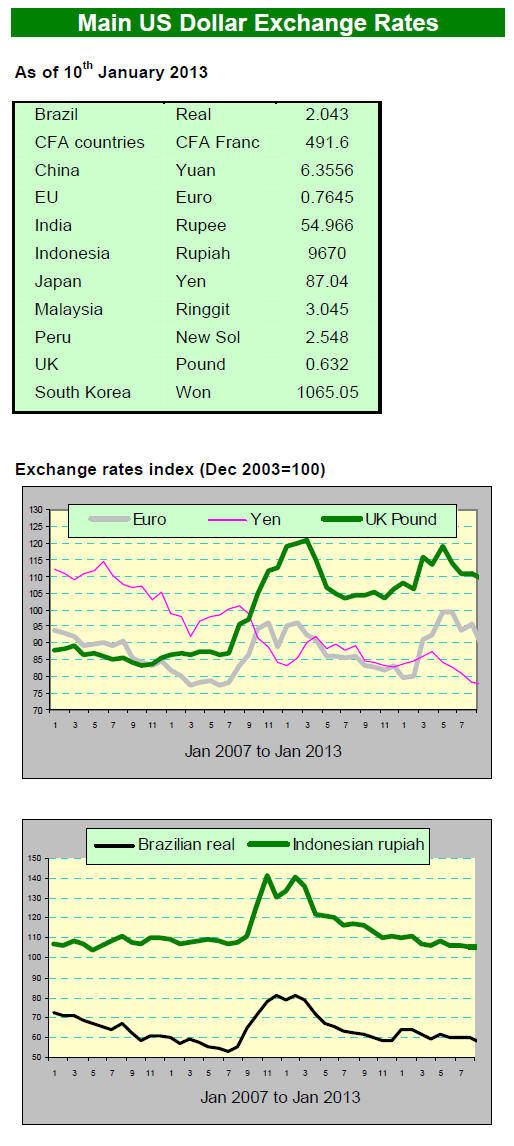2. GHANA
Ghana Revises Forest and Wildlife Policy
Ghana’s cabinet has recently approved the revised
Forest and Wildlife Policy which the focuses on the
non-consumptive values of the forest including
protection of water bodies, conservation of biological
diversity and ecotourism.
The revised Forest and Wildlife Policy is a shift from
the focus on timber production towards creating a
balance between timber production and realigning the
forestry sector to address poverty, contribute to
employment generation through plantations
development, promote good governance and forest
industry development as a means of wealth creation in
the rural areas and addressing rural-urban migration.
The new policy is therefore people centred providing
guidance on sustainable financing mechanisms that are
dependent on internally generated funds.
Timber sector operating well below capacity
The Chief Executive of the Ghana Timber Millers
Organisation, Dr Kwame Asamoah Adam, has made it
known that around 50-60 timber companies have
collapsed over the past decade. Companies that have
managed to survive the turbulence, mainly the result of
the financial and economic crisis and the stronger
monitoring and regulation of the forest resource, are
running well below their installed capacity due to raw
material shortage.
Estimates put the job losses from mill closures at
around 30,000.
While the current situation in the industry is serious
and exacerbated by high interest rates and electricity
tariffs as well as high fuel costs the Millers
Organisation said government policies to promote
value added products and curb illegal logging are
encouraging the industry.
The initiatives by the Forestry Commission and the
private sector to develop plantations are giving hope to
the Organisation for the future. The plantations being
developed will help solve the problem of raw material
shortages when ready for harvest.
The immediate problem is one of securing adequate
supplies of raw materials to keep mills running. The
government of Ghana is in consultations with the
government of Cameroon for the supply of logs to
firms in Ghana.
This arrangement is also expected to allow for
collaboration between the two countries in the
promotion of lesser used species from Cameroon.
Getting tough on illegal operators
The Ghana Forestry Commission (FC), is committed to
continuing the fight against illegal logging and
chainsaw operations in the country and has created a
special Rapid Response Unit (RRU) to tackle these
issues that challenge the sustainability of Ghana’s
forests.
A five-member team from the FC RRU was deployed
to the Western, Ashanti and Brong Ahafo regions and
has been successful in carrying out a number of
operations to combat illegal activities in the forest and
wildlife sectors.
The Chief Executive Officer of the FC, Mr Samuel
Afari Dartey, stated that 54 illegally constructed
hamlets within the Sui River Forest Reserve catchment
in the Sefwi Wiawso District in the Western Region
had been demolished, while 31 hectares of illegal
farms had also been destroyed in the Krokosua Hills
and the Tano-Offin Forest reserves.
In addition, 18 chainsaw machines and some 11,000
pieces of assorted sawnwood were seized from illegal
operators. A further 51 illegally felled logs were
confiscated in the Nkawie and Goaso forest districts.
Ghana set to access climate investment fund
The Forestry Research Associates (FRA) website
carries a story on the approval of Ghana’s investment
programme.
See:
http://www.forestry-research.com/forestryinvestment/
1692/fra-welcomes-news-of-ghana-forestryinvestment-
approval
FRA is a research and advisory consultancy that
focuses on forestry management, sustainability issues
and forestry investment.
The FRA site highlights, “Ghana’s Forest Investment
Programme has won approval from the World Bank in
a move welcomed by Forestry Research Associates
(FRA)”.
The approval means the African nation is one step
closer to gaining the $50 million in funding it needs to
help it implement climate change reduction strategies
through the safeguarding of its forests.
The cash will come from the Climate Investment Fund
and will be used to help engage the local community in
sustainable forestry management under the REDD+
reforestation scheme.”
Government bond sale oversubscribed
The government has successfully raised, a little over
GHc400million from its bond issue for 2013, an offer
which was oversubscribed by 450 percent.
Ghana accepted 402 million Cedis in bids for its threeyear
bonds at an oversubscribed auction last week,
with the average yield dipping to 16.7% from 21% at
the previous sale according to the Ghana Central Bank.
The Ministry of Finance and Economic Planning, on
whose behalf the Bank of Ghana issued the bond, said
the funds raised would be used to mainly to finance the
country’s maturing debts.
According to the Ministry, about 99% of the bids came
from foreign investors, which is an indication of
investor confidence in the Ghana’s economy.
Ghana’s inflation dips
Ghana’s annual consumer price inflation eased in
December but economic growth slowed in the third
quarter raising expectation of an interest rate cut.
Inflation dipped to 8.85 in December from 9.3% in
November. The economy grew by 1.7% year-on-year
in the third quarter of 2012.
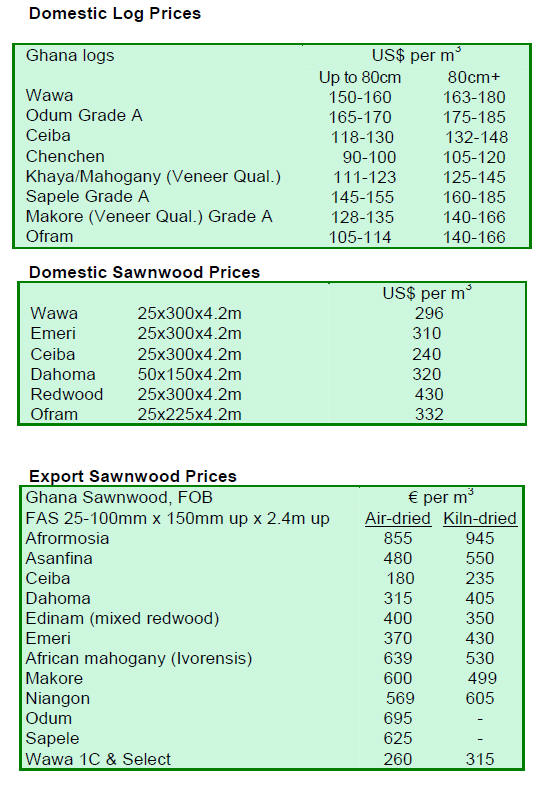
3. MALAYSIA
Weak global demand affects exports
The most recent export data shows that Malaysian
exports totalled RM 390.3 billion for the period
January to September 2012; this generated an average
monthly positive trade balance of around RM 10
billion.
By comparison, over the same period last year total
exports were slightly lower at RM 381.2 billion. The
marginal 2.4% increase year on year reflects the weak
global economy which is lowering expectations for
wood product exports.
Industry raises concerns on new minimum wage
Two major issues are of concern to the timber industry
at the moment; the changes in the statutory minimum
wage provision in Malaysia which came to force on 1st
January 2013 and the EU FLEGT which is due to enter
into force in March.
Analysts report that Malaysian furniture manufacturers
feel especially hard hit as they struggle to cope with the
changes in wage structures while preparing for
compliance with the EU FLEGT requirements.
The Malaysian government, trade bodies and
associations have been holding consultations for
stakeholders and have been disseminating information
to exporters. Throughout the industry there is
considerable apprehension on how the EUTR will
affect the wood product exporters and Malaysia’s
exports to the EU.
By law, the Malaysian minimum monthly wage, by
law, is now RM 900 (approximately US$ 290) in
Peninsular Malaysia while in Sabah and Sarawak, the
new rate is RM 800 (approximately US$ 260).
The timber industry in Malaysia is trying to adjust to
this new wage structure which something of a problem
for those companies which include room and
occasionally food in their workers employment
contract.
Some companies are saying the new law does not
reflect the local living expenses, pointing out that it is
more expensive to live in the cities than in the rural
areas where logging and some timber companies
operate.
This point is particularly pertinent in the eastern
Malaysian states of Sabah and Sarawak.
Sabah timber association calls for government support
Recently, as reported in the Daily Express, 2 Jan 2013,
James Hwong, president of the Sabah Timber
Industries Association, called on the government to
help the downstream timber industries in the state.
Hwong said that stricter regulations on logging natural
forests could reduce the supply of raw materials to
manufacturers forcing them to import the raw materials
needed in their manufacturing processes. The report
says a call was made for government to not impose any
fees or restrictions on timber raw material imports.
Hwong noted that worldwide, the trend is towards
‘green’ products and said “In order to survive, the only
way is plantation timber”.
Sabah export statistics
Data on timber exports from Sabah were released
recently. For the period January to October 2012
exports were:
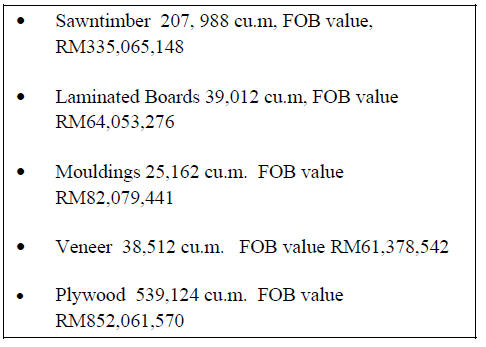
New minimum wage levels an issue for industry in
Sarawak
Comments on the new minimum wage structure for the
state have focussed on the impact the changes will
have on overall wage bills as, already, wages are
trending up due to the problem of labour supply.
The plantation sector in Sarawak is especially
dependent on foreign labour because of its low
domestic population.
The domestic labour force is not attracted to working
in the forestry and timber sectors, preferring to work in
an urban environment instead.
Sarawak log price indications
Sarawak log export prices are provided as a range to
take into account shipment size and variations in log
quality and diameter.
FOB prices for Meranti SQ quality logs provides a
good indicator of overall market price trends for
Malaysia natural forest logs as prices for other species
usually follow the same general trends as Meranti

Sarawak export data
Sarawak export data for the period January to
November 2012 was recently released and is
summarised below:
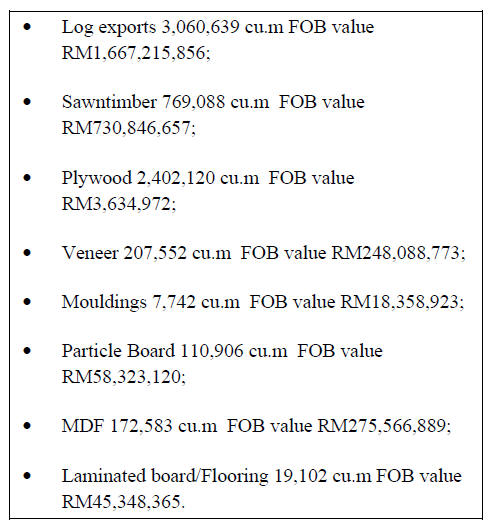
For the period January to November the top buyers
of
logs from Sarawak were:
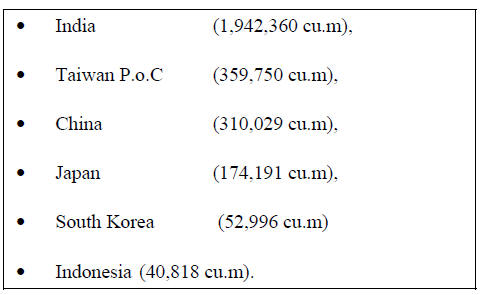
The top buyers of plywood from the state of Sarawak
were Japan (1,297,092 cu.m), South Korea (299,462
cu.m) and Taiwan P.o.C (214,406 cu.m).
4. INDONESIA
Indonesian legality verification system enters
into
force
Indonesia and the European Union have finalised an
agreement aimed at ending trade in illegally-sourced
wood through the implementation of the Voluntary
Partnership Agreement (VPA).
Indonesia has introduced the mandatory Timber
Legality Assurance System (TLAS) or in Bahasa
Indonesia, Sistem Verifikasi Legalitas Kayu (SVLK),
which is defined in Forestry Regulation Number
P.38/Menhut-II/2009 (amended by P.68/Menhut-
II/2011).
Under the new arrangements Indonesian exports will
be covered by a V-Legal/FLEGT license which verifies
that the timber products conform with the timber
legality assurance system (TLAS).
The new Indonesian legality regulation, which is now
in effect, applies to 26 products defined by their HS
Codes with a further 14 products to be included in
January 2014.
These additional 14 categories of wood products are
mainly manufactured by small and medium enterprises
producing handicrafts and secondary wood products.
V-Legal test shipment concluded
Indonesia and EU have conducted a test shipment of
some products for which a V-Legal documents/
FLEGT-License is mandatory.
The test run will be conducted in two phases, the first
was during the period of October-December 2012 in
Indonesia and the second in some EU countries during
November-February 2013.
The first test shipment test from Indonesia was made
from PT Kayu Lapis Indonesia (KLI) a company in
Central Java .
The test run launch was attended by Deputy Minister
of Trade Mr. Bayu Krisnamurti who explained that
shipment tests of V-Legal products will be conducted
by 17 Indonesian registered exporters of industrial
forest products..
The Deputy Minister anticipated that this trial would
identify any deficiency in the system so that exports of
timber products from Indonesia will run smoothly and
comply with the EUTR as well as demands formproof
of legality from other countries.
The export shipment test was aimed at demonstrating
the readiness of Indonesia to supply verified legal
timber product to world timber markets.
Three certification schemes operate in Indonesia
Forest management certification plays a significant role
in sustaining Indonesian forest resources and three
schemes are currently operational in the country
namely; FSC, LEI, and PEFC.
The implementation of certification in Indonesia has
been supported by many agencies and organisations
such as The Borneo Initiative (TBI), WWF, Ford
Foundation, ITTO, Tropical Forest Foundation (TFF),
the Multi-stakeholder Forestry Programme (MFP) and
many local consultants.
The TBI has supported certification in 19 forest
management units (FMUs) covering some 1.2 mil.ha.
TFF has supported 7 FMUs and the FSC has certified
six FMUs in a period of 12 months.
The certified forest under LEI system amounts to
around 0.4 mil. ha. of natural forests;
0.97 mil. ha .of plantations and 26.7 thousand ha. of
community forests.
PEFC certification is new to Indonesia and PEFC
recently inaugurated a national governing body called
the Indonesian Forest Certification Cooperation
(IFCC).
This body is now developing, with stakeholders, a
consensus based standard and guidance for forest
certification.
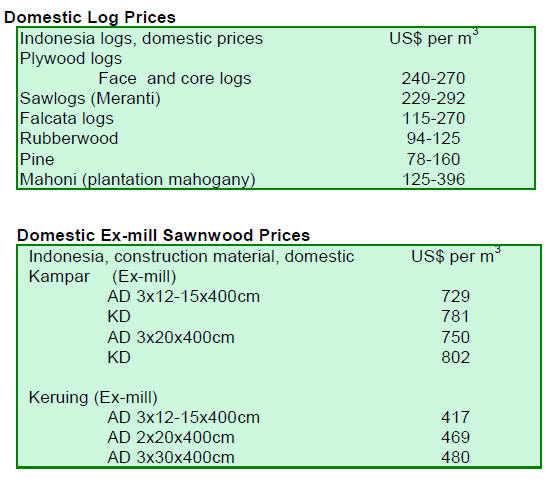
5. MYANMAR
Change, the theme for 2012
In the words of a local analyst ‘2012 was a very
eventful year for Myanmar as there were so many
changes’. The newly elected civilian government now
includes the internationally known Daw Aung San Suu
Kyi who was recently elected to the legislative
assembly.
The political party which she leads participated in the
2012 by-elections and won 43 of the 45 seats
contested. In other developments, journals have been
given more freedom to report on issues affecting the
country and express more freely on matters which once
had to be avoided.
Myanmar plans log export ban
Taking advantage of the greater freedom in the press
many commentators have expressed their views on the
deteriorating situation in state-owned forests.
Except for some plantations, almost all the forest land
in Myanmar is technically state-owned. Some writers
have called for a logging ban. Daw Aung San Suu Kyi
also spoke very strongly on the subject of the depleting
natural resources during her December 2012 visit to
Magwe in Central Myanmar.
The ‘Myanmar Herald’ has reported that the Minister
of Environmental Conversation and Forestry
(MOECAF), in an interview for the newspaper,
indicated that a total log export ban will be introduced
to take effect starting April 1st 2014.
It was apparently explained that some 15 months will
be needed to clear all current logging contracts. The
Herald also reported that the Minister has met with the
Chinese Ambassador on several occasions and that the
issue of the illegal transport of logs into China was
discussed.
News on steps to abolish log exports first came to light
during October 2012 and the teak market reacted
sharply.
At the moment reports suggest that there are
considerable volumes of unshipped logs from
outstanding contracts in Yangon and in upper
Myanmar and that owners are trying to move the logs
out of the country as soon as possible.
Merit of total log ban questioned
Some analysts are questioning the wisdom of a total
log export ban as Myanmar needs to build up its
industrial capacity to process the higher grades teak
logs internally.
As analysts point out, while there are specialist timber
processing companies in Myanmar which can process
high-end teak products there are too few for Myanmar
to become a potential natural teak export ‘tiger’.
Some really high grade teak logs fetch very high prices
in the tenders and auctions and analysts argue that the
domestic mills are not able to pay as much as foreign
competitors.
It is argued that the highest grades should be auctioned
in an open market where local and foreign buyers can
participate and that, upon winning the bidding, the
foreign buyers should be given permission to export
the logs. However the proponents of a total log export
ban remain adamant at present.
Current log export market erratic
The Myanmar timber market is erratic and unstable at
the moment and trends are difficult to discern. The
trade in non-teak hardwood logs is much the same as in
previous years; fresh logs being sold and shipped
quickly while logs which have been harvested some
time ago are slow to move.
The pressure is now on buyers to ship logs which have
been paid for as indications are that exports beyond the
proposed date of entry into force of the log ban will not
be entertained.
Myanmar Teak Log Auction Prices (natural forest logs)
Average prices during the Teak tender sales in the final
quarter of 2012 are shown below. Prices are Euro per
hoppus ton
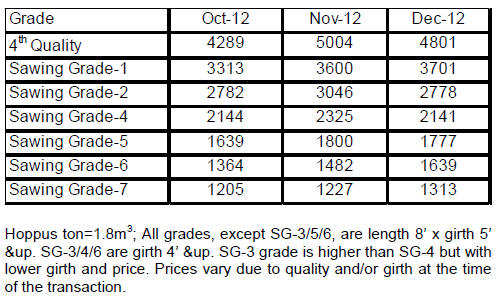
6.
INDIA
2013 begins on a confident note.
While the Indian economy could not avoid the impact
of the weak global economy and also had its share of
economic shocks, activity in wood based industry was
rather resilient and demonstrated continued expansion,
albeit more slowly than over the past few years.
Imports of logs and sawnwood in fiscal 2011 totaled
Rs.94 billion compared to the level of Rs.60 billion in
fiscal 2010.
Increased imports of plywood and veneers and other
panel products such as MDF and Particleboard were
recorded and imports of wooden furniture were higher
than in previous years.
In total, fiscal 2011 wood product imports came to
Rs.121 billion compared to Rs.81 billion in the
previous financial year.
Domestic market buoyant
Weakness of the Indian Rupee resulted in a slowing of
some imports but still a negative trade balance was
recorded largely driven by imports of petro-products,
prices of which remained firm throughout the year.
Despite the fall in exports, because of weak overseas
demand, the colossal domestic market and continued
overall economic growth generated record breaking
foreign investments of some US$ 22 billion in 2012.
Forecast decline in India’s GDP
Unfortunately, India’s GDP slipped below 6% over the
past year. India's economy is forecast to grow by about
5.8% this year, the slowest rate for many years
according to official forecasts.
The Ministry of Finance is on record as saying it
anticipates India's growth rate to have accelerated
slightly in the second half of the financial year which
ends in March 2013 generating an annualized 5.8%
growth. However the burst in growth will not be
enough to improve GDP expansion to the forecast of
7.6%.
While India has recently introduced reforms to attract
foreign investment in the retail sector analysts doubt it
will be enough to generate the double-digit growth
rates achieved in the past.
Businesses expect 2015 turn-around in global
economy
Reports of a survey of over 250 executives of small,
medium and large companies by the Indian PHD
Chamber says most executives expect the domestic
economic climate to improve in coming fiscal year
despite continued weakness in the US and EU
economies.
Almost half of those surveyed expected the global
economy to begin a full revival no sooner than 2015
while most of the others surveyed were not so
optimistic pointing to a 2017 recovery.
Domestic investment was not expected to improve but
neither would it decline and there seemed to be more of
a tendency in the responses of executives to anticipate
that economic reform measures by government had the
potential to stimulate investment.
The survey identified that the high the cost of doing
business is a continuing burden and hampers industrial
production. In terms of commodity supplies most of
the executives expected raw material prices to continue
moving upwards.
Slowing housing sector impacts timber industries
Home buyers in India now face additional costs in the
form of stamp duty and VAT on transactions.
This is negatively affecting the housing market by
slowing investment and this in turn is negatively
affecting the timber industry.
The impact of the duty and VAT on housing demand
has been taken up by the relevant ministries and
analysts say the timber industry is hopeful that a
solution will be found and that housing growth will
expand.
The Indian timber industries are also being hard hit by
increased imports of low price plywood and other
panel products.
An anti-dumping duty is levied on some MDF
suppliers which is some relief but they still feel the
burden of rising raw material and labour costs.
There are reports of acute shortages of labour in many
sectors in India especially the timber industries.
Smuggling of rare woods continues
Sandlewood (Santalum alba) Agar wood (Aquillaria
agalocha) and Red sanders (Pterocarpus dalbergiodes)
are the target of illegal loggers, poachers and
smugglers in India and the pace of criminal thefts of
precious trees continued in 2012.
These timbers are used to satisfy demand for traditional
medicines and perfumes, a demand that it is difficult to
deflect. Analysts point out that to solve the problem of
illegal harvesting and theft consumer demand must be
met from sources other than the natural forests.
Some Sandalwood plantations are being established
and plantations for Agar wood are being created in
India and in Australia, Vietnam, Thailand and other
neighbouring countries. These plantations, when
mature, will augment supplies and help satisfy Indian
demand.
Analysts point out that there is a need to take up large
scale planting of red sanders by private and public
organizations to increase availability and thus limit
illegal felling.
Sales of domestic teak and other hardwoods
Throughout 2012 demand for local hardwoods was
buoyant and sales were brisk at the auctions where
prices firmed throughout the year.
Indian teak is generally equivalent in terms of colour
and quality to Myanmar teak, say local analysts, and
this is one factor behind for the strong demand for
locally grown teak.
In 2012 the Indian rupee lost ground to major
currencies and thus imports became more expensive
and this was another factor for the firm demand for
local teak as opposed to imported Myanmar teak which
is priced in US dollars or euro.
Imported plantation teak is a viable and lower cost
alternative to natural teak however say analysts, while
the volume of imported plantation teak has been
increasing the quality continues to be poor.
Average prices realised in sales held at government
teak depots in Western India are illustrated below.
Freshly harvested logs attracted active bidding. The
prices below are per cubic foot ex depot.
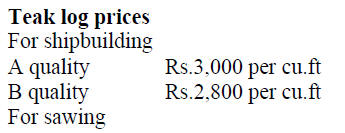
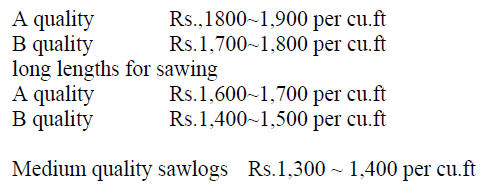
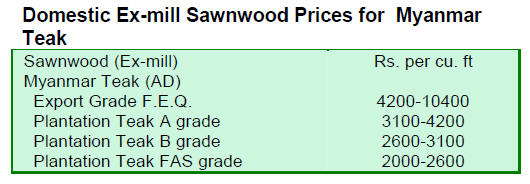
Calls to improve teak plantation stock
There has not been any appreciable rise in the C&F
prices even though the weaker Rupee has increased the
landed costs of plantation teak.
Some in the industry are complaining that the quality
of plantation teak logs from West Africa and also
Central and South America is deteriorating. Importers
say it is high time that teak plantation managers in
these regions take steps to improve the quality of the
growing stock and in future plant quality cloned
saplings.
Indian experts say that while such moves may increase
the cost of plantation establishment the investment will
earn excellent dividends by way of better prices for
harvested good quality logs.
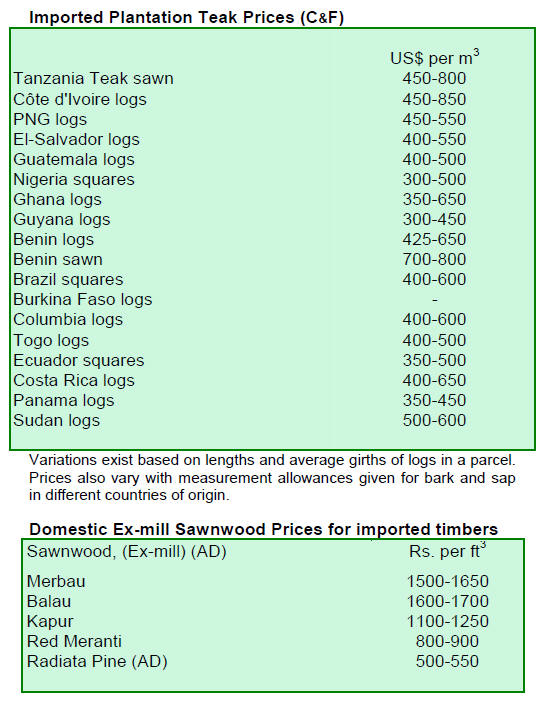
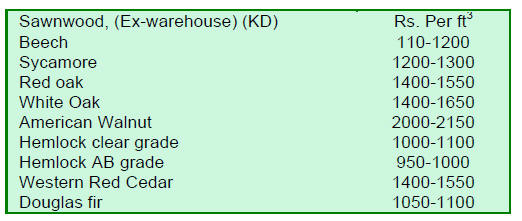
7.
BRAZIL
2012 export performance
Brazil’s exports of wood products (except pulp and
paper) delined 1.4% in 2012 compared to 2011, from
US$ 2,396.2 billion to US$ 2,362.6 billion.
Pine sawnwood exports fell 7.4% in value in 2012
compared to 2011, from US$ 170.5 million to US$
157.9 million.
In terms of volume, exports of wood products dropped
3.0%, declining from 741,400 cu.m to 718,900 cu.m
over the period.
The volume of exports of tropical sawnwood declined
16.0% in 2012, from 451,900 cu.m in 2011 to 379,500
cu.m in 2012. The decline in export value was almost
19%, down from US$ 238.2 million to US$ 193.8
million, year on year.
On the other hand pine plywood exports increased
14.5% in value in 2012 compared to 2011, from US$
324.9 million to US$ 371.9 million.
The volume of pine plywood exports increased 13.7%
during the same period, from 865,600 cu.m to 983,900
cu.m.
However, exports of tropical plywood fell from
74,500cu.m in 2011 to 58,200cu.m in 2012,
representing a 21.9% decline.
In value terms, exports of tropical plywood fell 20.4%
in 2012, declining from US$ 45.5 million in 2011to
US$ 36.2 million last year.
The value of Brazilian export of wooden furniture
dropped from US$ 496.1 million in 2011 to US$ 474.9
million in 2012, representing a 4.3% decline.
Tropical Sawnwood Exports from Mato Grosso
Mato Grosso accounted for around two thirds of the
Brazilian trade balance surplus generated in 2012,
equivalent to US$ 12.89 billion of the total surplus
US$ 19.43 billion. Despite the ups and down in the
global economy the State of Mato Grosso achieved
positive overall export growth.
The Brazilian Ministry of Development, Industry and
Foreign Trade of Brazil (MIDIC) has data indicating
the contribution to the positive trade balance by various
products, with soybeans and tropical wood products,
especially sawnwood, featuring prominently.
Mato Grosso state exported 723,000 cu.m of tropical
sawnwood in 2011 and this increased by 12% in 2012,
to 812,000 cu.m.
On the other hand, there was a 4% drop in tropical
sawnwood export values from Mato Grosso with
revenues falling from US$ 45.4 million in 2011 to US$
43.7 million in 2012.
Pará State timber exports fell in 2012
Pará state is one of the principal exporters of tropical
sawnwood in Brazil, according to the Ministry of
Development, Industry and Foreign Trade of Brazil
(MDIC). In 2012 tropical sawnwood exports from the
state declined slightly in 2012 such that the state was
responsible for 40% of Brazilian tropical sawnwood
exports compared to 46% in 2011.
In 2012, Pará state exported 151,200 cu.m of tropical
sawnwood, while in 2011 the state exported 206,800
cu.m, representing a 27% decline in export volumes. In
value terms, the decline amounted to around 30%, from
US$ 119.5 million in 2011 to US$ 84.2 million in
2012.
A significant decline in tropical plywood exports from
Pará state has been reported. In 2012, the state
exported 4,900 cu.m of plywood, while exports in 2011
were 8,900 cu.m. This represents a 45% decline year
on year. In terms of value, the fall was 34%, from US$
6.2 million in 2011 to US$ 4.1 million in 2012.
Brazilian furniture Sector set to expand 2013
The Brazilian furniture sector is expected to continue
to grow in 2013. According to consumer research by
the Institute of Industrial Studies and Marketing
(IEMI), some 90% of domestic consumers had, by the
ned of 2012, already planned their future furniture
purchases.
The recent research identified that bedroom furniture,
especially wardrobes, was the main feature for
consumers in 2012. In 2012, the number of items of
furniture sold increased 4.5% overlevels reported in
2011 while, in terms of value, sales revenue jumped
8.0%.
For 2013 an almost 7% increase in the number of items
sold is forecast and earnings are forecast to rise around
10%. The IEMI report foresees an overall 5.5% growth
in the furniture sector during 2013.
Investment in construction to drive domestic
furniture demand
The Association of Furniture Industries of the State of
Rio Grande do Sul has reported that the performance of
the furniture sector in 2012 was satisfactory and the
association is anticipating an increase of 3.5% in the
state’s furniture production over levels in 2012.
The forecast growth in the sector is based on
expectations of continued expansion of civil
construction activity and the continued ease at which
consumers can access credit for house purchases and
purchases of durable goods such as furniture.
Further support for the IEMI forecasts derives from
expectations of increased exports to new markets,
establishment of specialized multi-brand shops,
detailed retail research to target promotion through the
internet and an expansion of e-commerce.
The growing purchasing power of the expanding
Brazilian middle class is good news for furniture
manufacturers as well as for importers of high end
furniture from around the world.
State of Pará plans more plantations
The Government of State of Pará, in the Brazilian
Amazon, has launched a state plantation programme to
stimulate establishment of more forest and wood based
industries.
This programme will require combining the resources
of public institutions with technological development,
re-organization of the production chain, changes in the
law to provide guarantees for investors and the
nurturing of family agriculture.
One of the main challenges, say analysts, will be
regularising land registration issues in order to attract
investments and provide legal certainty for investors. A
further challenge will be to provide for swift state
government responses to the environmental licensing
processes required for plantation projects.
Some 70% of the State of Pará is covered by natural
forests and under various forms of protection. It is
reported that around 14 million hectares of degraded
land will be included in the new plantation programme.
Plantation forests in the state currently amount to about
300,000 hectares which is consider far too small to
meet the demand of the growing timber sector in the
state.
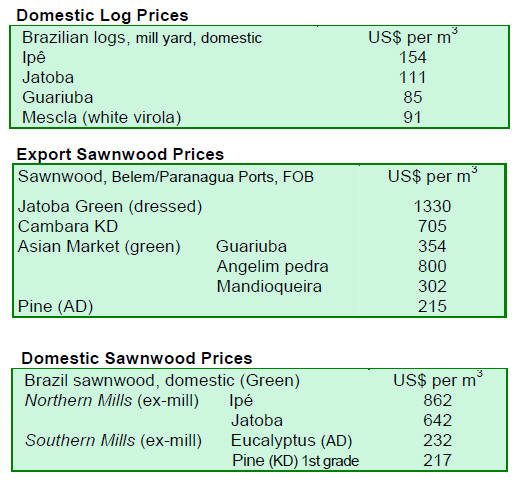
8. PERU
Concerns over forest concession
management
Peru’s agriculture minister, Milton Von Hesse La
Serna has reportedly expressed deep concern about the
current forest concession system in the country. He
said that the forestry institutions are weak and that the
regional governments are not managing the forests to
the required standard.
To address these short comings the minister is calling
for improvements in the institutional framework for
forest concession allocation and management through
dialogue between stakeholders including OSINFOR,
the ministry of agriculture, regional governments, local
governments and civil society.
Currently, forest concessions are granted by regional
governments however, many of the regional
institutions are said to be lack of technical and
managerial capacity for this task and there are fears of
favouritism in the decision making process when
concessions are allocated.
Only 21% of concessions operational in Ucayali
Reports indicate that the forestry authorities in Ucayali
are facing a critical situation as only 21% of the
allocated forest concessions are operational. A round
table discussion has been held to try and identify the
reason for this and to offer solutions.
Among the proposals put forward was a new payment
structure moving away from an advanced payment
system for which a flat rate is calculated on the
assumption that the concessionaire will extract 65% of
the allocated standing volume.
Another proposal was to allow small logging operators
and sawmill owners to undertake harvesting in
allocated areas. Apparently current policies do not take
account of the needs and capacity of small operators.
The roundtable also proposed the creation of a Forest
Recovery Fund and the need to streamline procedures
for evaluating and approving environmental impact
studies in forest management plans.

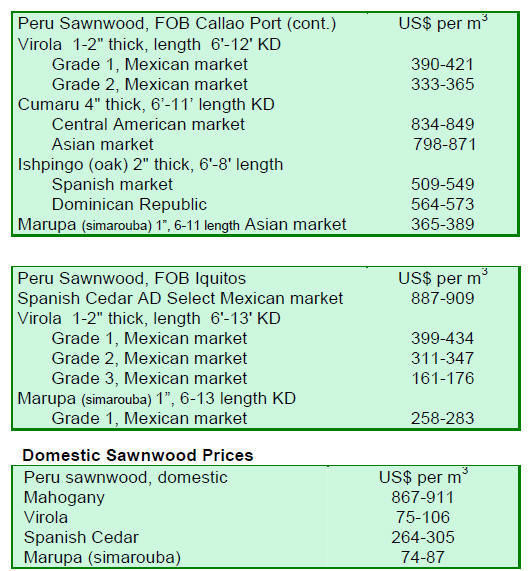
9.
GUYANA
Export prices at satisfactory levels
For the period under review Guyana did not export any
Greenheart logs however, there were exports of
Purpleheart logs. Standard sawmill quality Purpleheart
logs for export were priced at US$ 385 per cubic metre
FOB.
Purpleheart fair and small sawmill quality logs were
also exported and satisfactory price levels were
recorded.
Export FOB prices for Mora logs of standard and fair
sawmill quality reached US$ 150 per cubic metre while
small sawmill quality logs achieved a price of US$ 135
per cubic metre.
The demand for Guyana sawnwood was reportedly
firm for the period and attractive prices were achieved.
‘Undressed’ Greenheart sawnwood attracted the best
prices.
Undressed Greenheart (select) was priced at US$ 1,410
per cubic metre FOB. Only select Undressed sawn
Purpleheart was exported and the best price secured
was around US$ 1,100 per cubic metre FOB.
Undressed Mora (select quality) also made a notable
contribution to export earnings as the top end price was
US$ 700 per cubic metre FOB.
EU a major market for Guyana producers
Guyana’s structural and durable timbers were marketed
in Asia and the Caribbean but most went to markets in
the EU. There were also buyers in the Middle East as
well as South and North American markets.
Dressed Greenheart sawnwood prices were firm in the
period reported at around US$ 1,534 per cubic metre
FOB. Exporters of sawn and dressed Purpleheart
lumber also managed to secure good prices in the
region of US$ 1,080 per cubic metre FOB.
Guyana’s Washiba (Ipe) continues to attract firm
demand in N. America as reflected in prices as high as
US$ 2,300 per cubic metre FOB in this market.
Only BB/CC plywood was exported in the period
reviewed and the maximum price achieved was US$
584 per cubic metre FOB in the main market, the
Caribbean.
Guyana’s Roundwood (Piles) secured maximum price
of US$ 616 per cubic metre FOB in the European
market, while Pole prices were US$ 354 per cubic
metre FOB for the North America market.
Caribbean market for shingles picks up amid slack
in US demand
Splitwood (Shingles) made a valuable contribution to
export earnings at prices of US$ 864 per cubic metre
with the Caribbean being the primary export as the
building industry in N. America is subdued at this time
of the year.
The export of doors and windows frames manufactured
from timbers such as Kabukalli (Cupiuba) and
Purpleheart (Amarante) continue to contribute to
export earnings.
LUS handbook for homeowners and builders
The Forest Products Development and Marketing
Council, the Guyana Forestry Commission and the
Forest Products Association have jointly produced a
handbook to encourage home owners and builders to
use lesser know timbers.
This initiative came in the wake of the housing boom
in Guyana which resulted in shortages of the popular
timbers and thus caused timber prices to rise in the
domestic market. It was recognised that the advantages
of using Lesser Used Species in building projects for
consumers and end users were both affordability and
availability.
The handbook is designed for end users of timber as it
provides information on the properties of the LUS
alternative species in terms of application compared to
the more commonly used timber species in Guyana.
The Guyana LUS e-handbook can be found on the
FPDMC website www.fpdmcguy.org.


